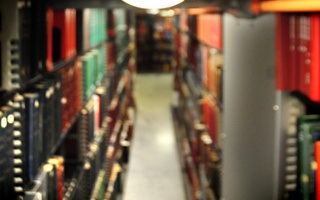THE WAR may seem like it's a long way away, but it's as close as North Cambridge where Bolt, Beranek and Newman works on antisubmarine warfare devices. Its basic research on acoustics is useful in developing acoustic and seismic sensors used in Indochina. Parachuted from planes, the acoustic sensors become caught in trees where they pick up "enemy" conversations. Seismic sensors--disguised as tropical plants and animal droppings--detect ground vibrations caused by human movement. The information from both types of sensors is relayed to the central computer in Thailand, where it is used to determine bombing targets. (Although "people sniffers" can now distinguish between Americans and Vietnamese--meat-eating Americans have different chemicals in their perspiration--no sensors have yet been developed to distinguish between the "enemy" and the civilian population. As the head of the Defense Department's special project on the electronic battlefield admitted, "A group of wood-cutters...might look like a squad to (the sensors); you could make a mistake, I think.")
And the war is as close as Tech Square, where Polaroid makes the filters necessary for terrain-following radar. This radar makes it possible for planes to fly in the dark close enough to the ground to detect the enemy" with infrared sensors, which respond to the warmth of their bodies, and with "people sniffers," which detect the ammonia in human perspiration. Without the terrain-following radar, the planes would risk flying into a mountainside, for they fly without lights to avoid providing a target for anti-aircraft fire. The A-armed with these devices, "makes ground movement after dark a nightmare," the plane's manufacturer boasts.
And it's as close as Dorchester, where Keystone Manufacturing makes bomb fuse parts for Indochina. Many of the women who work there are black. Most don't know what they are making.
MITRE, Sanders Associates, and Helio Aircraft are located right out in Bedford. Sanders makes both "defensive" and offensive radar to keep us on the offensive in Indochina. "Sanders continues as a leading supplier in (the) field (of electronic warfare systems) where, almost uniquely, advanced technology provides the margin of defense supremacy...," the company's Annual Report for 1971 is proud to say.
MITRE--an MIT spin-off--provides the brains behind the electronic battlefield. It calls itself the "systems engineer behind the Igloo White (electronic battlefield) sensor exploitation program." In other words, it figures out how many sensors to use, how many planes, and in what arrangement to maximize their effectiveness in destroying anything that moves. Domestically, MITRE uses this systems-engineering sophistication to coordinate police communications. However, the military insist that the majority of its work be military-oriented because MITRE provides "a degree of expertise unobtainable elsewhere in the country."
Helio produces an STOL--short take-off and landing plane--which can take off in an area smaller than a baseball diamond. It was developed in the early 50's by a B-School professor. Lynn Bollinger, who founded the company along with the head of MIT's Aeronautics Labs. They sold their first model to the CIA for use in the secret war in Laos. It proved very helpful in reaching the otherwise inaccessible mountain hideouts of the Meo tribesmen. Now they produce STOL's for the Air Force for use in psychological warfare (equipped with speakers to broadcast to the country side), armed reconnaisance and precision air drops. The planes come armed with 3-barrel gatling guns, 2.75-inch rockets, and several new types of bombs, including TV. and laser-guided bombs, and bombs which follow a moving truck by homing in on its ignition system. The U.S. is giving them to the South Vietnamese as part of the Vietnamization program.
All of the companies on this map are involved in military contracting--for this war, and for future wars. AVCO, for example, develops the laser technology which is already being used for laser-guided bombs. It's also working on future military uses of lasers, which include a laser "zap gun" for burning or blinding the enemy; guidance systems for missiles; range-finders for tanks; and techniques for defusing incoming ICBM's. The Defense Marketing Survey--the authoritative source on weapons manufacturers--calls it the "space age miracle beam of light," and its space-age potential is being developed right in Everett.
Read more in News
For Governor: FurcoloRecommended Articles
-
Remembering a Cuban TragedyMention the word "Cuba" in the United States and many people will immediately think of Bacardi, Montecristos and Guaguanco. To
-
THE REAL WARTo The Editors of the Crimson: Has the Crimson decided that the war in Laos. Cambodia, and Vietnam is only
-
Bombs May be Dropped Over Yard, But Won't Land Here"Enemy bombers will probably drop their missiles directly over the Yard," according to an argument used to persuade recalcitrant students
-
Nodes To Watch City WeatherHarvard researchers and a local technology company are developing a network of weather sensors that will make the Cambridge climate
-
 HCL Ups Sustainable Initiatives
HCL Ups Sustainable Initiatives -
Robotic Insects See ImprovementFlying insect-like robots that would be able to navigate situations too dangers for humans are one step closer to becoming a reality.













